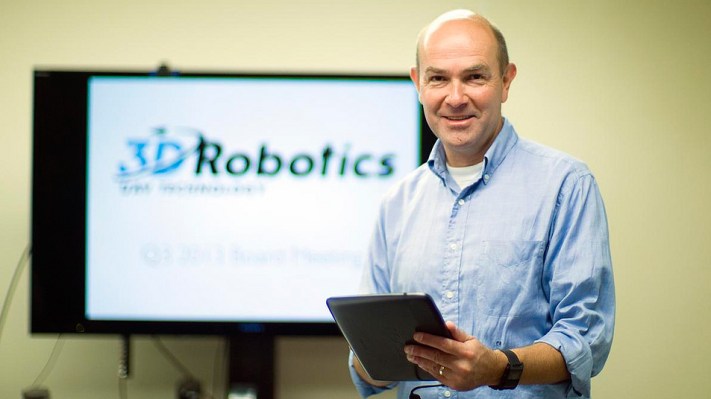At a recent Mayfield Fund dinner for hardware entrepreneurs and investors hosted by the firm’s partner Tim Chang, former Wired editor-in-chief-turned-drone entrepreneur Chris Anderson opened up about how he turned a hobby of building robots and drones into an actual business.
Anderson, who recently founded aerial machine developer 3D Robotics, has five children and while still at Wired, started a website called Geek Dad, which suggested fun, technical projects for parents and kids. One of the projects he worked on with his children was building a Lego Mindstorm robot, but he struggled with the project and thought, “if only there was a cooler robot and a better flying plane to build.”
It was 2007, and Anderson’s progress into finding a better flying robot began with a Google search. But he quickly realized that what he was looking for was a drone and he could actually build these for under $1,000. So he built an online community around building your own drones, called DIY Drones, which drew on volunteers to help build drones. The first drone was built collectively in spare time by engineers from Apple, Google and Microsoft, among other companies.
The DIY Drone community was trading code and design, and Anderson’s first assembly line to create the drones was composed of his five children. Via the site, he also met a young man who helped him with manufacturing on the side. So he decided to start selling the drone kits he built.
This continued for a while, in which Anderson did this on the side as a project with his children. One day he looked at the sales, and he realized DIY Drones was doing around $5 million in revenue in the year. And thus, he saw that this was a real business and a passion, and he started on his journey as an entrepreneur. He raised cash (including some from Mayfield), built a factory in Tijuana and started shipping drones.
The high-powered, connected devices the startup is manufacturing and selling would normally only be able available to aerospace industry or the military. Now, these controlled drones can be made cheaper, and can be put towards all sorts of commercial use cases, including delivery.
3D Robotics’ current portfolio includes a single plane-style drone and four copter drones. One of the company’s flagship devices is the Iris, a $720 drone that can be controlled with ease from a PC or an Android device (as long as you have the corresponding app) that can also follow paths “drawn” on an on-screen map thanks to its built-in GPS.
Of course, Anderson highlights the challenges around finding product market fit. “Kits are a lot of work and complexity is the enemy. I realized what people really wanted was simplicity — easy is the killer app.”
At the dinner itself, there were a number of other interesting observations around the challenges of founding and running a hardware startup. As one entrepreneur pointed out, you can upsell software and online services and apps because you can measure MAUs and DAUs. But there are very little analytics opportunities around measuring daily interaction within hardware.
There’s also the challenge of building three mini teams in one engineering group — there’s a hardware team, a software team, and an API platform team. In order to bridge the divides between these groups, there needs to be technical leadership in place that can arbitrate as well as understand the needs of all these groups.
The community that Anderson tapped into draws some comparison to those created on Kickstarter and Indiegogo. Indiegogo’s co-founder Danae Ringelmann, who was also at the dinner, talked about the number of reasons people use the platform to launch their projects. Some of these include people and participation in the campaign — and mentioned that campaigns with videos almost always raise more. “You need to not only talk about what you are doing, but why you are doing it,” she said.
As Anderson explains, “Our secret sauce was an open platform and a lot of community. … Because it tapped into passion, I knew it would have an impact, and so I decided to build a company out of an open-source hardware project.”
Photo: Christopher Michel under a CC by 2.0 license
